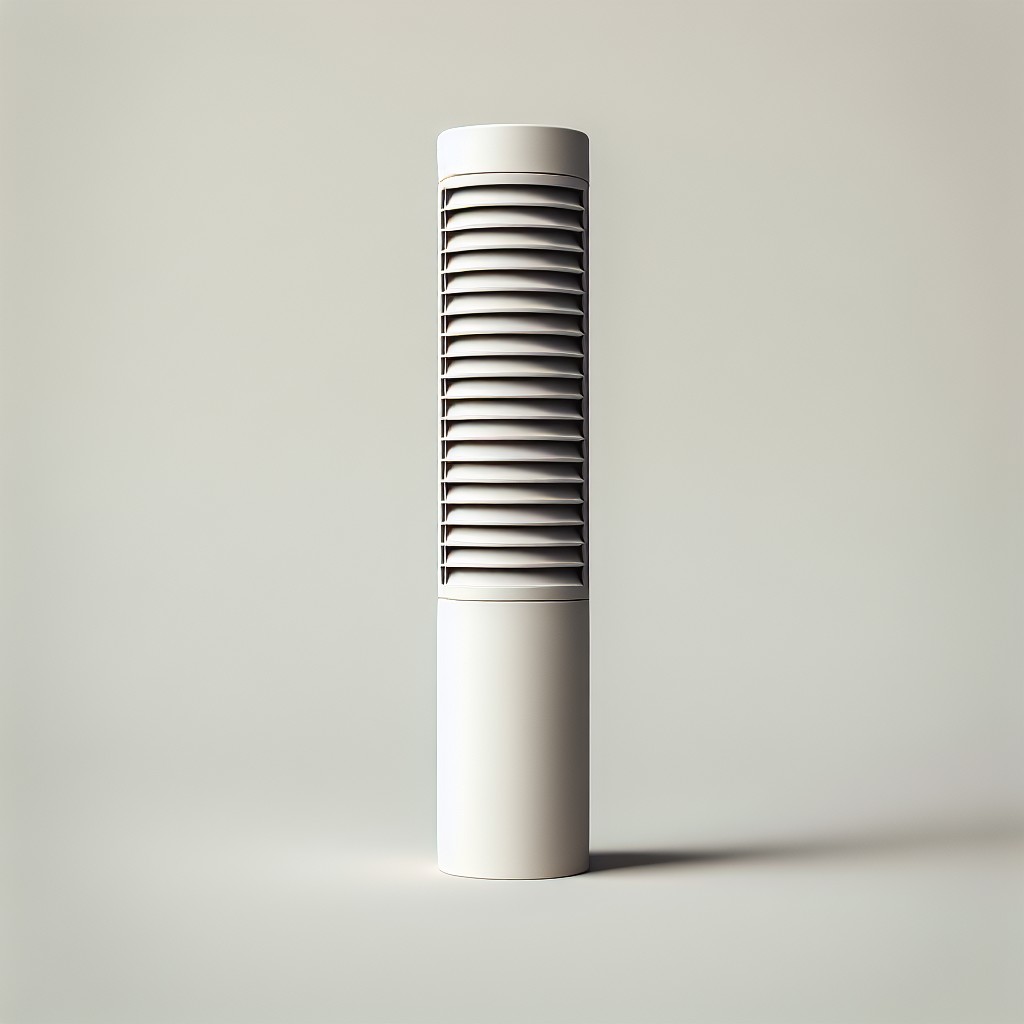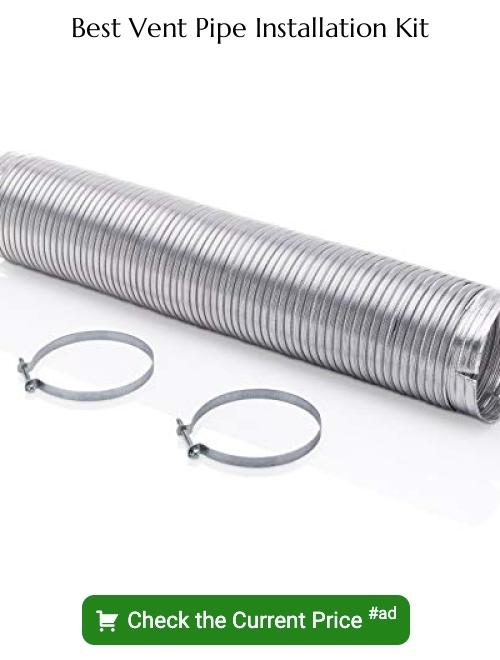Last updated on
Understanding what a vent pipe looks like is crucial because it plays a significant role in maintaining the overall health and efficiency of your home’s roofing system.
Key takeaways:
- Vent pipes are cylindrical and range from 1.5 to 4 inches in diameter.
- They typically emerge vertically from the roofline near bathroom or kitchen fixtures.
- Vent pipes are made of materials like PVC, cast iron, or ABS.
- Proper placement is important to prevent harmful gases from entering the home.
- Roof flashing is used to prevent water leaks around vent pipes.
Visual Characteristics of a Vent Pipe

Vent pipes typically emerge vertically from a building’s roofline, standing out against the horizontal orientation of shingles or other roofing materials. They are cylindrical in shape, resembling a small chimney but without a cap. Standard colors range from black to white, reflecting the material—often PVC, cast iron, or ABS—though metal vent pipes may display a metallic finish. The pipe’s diameter usually spans between 1.5 to 4 inches, depending on the requirements of the plumbing system it serves.
In residential buildings, these pipes often can be seen running beside a bathroom or kitchen, as they are directly connected to the plumbing fixtures below. They may be fitted with a slight angle at the top to prevent rainwater ingress or covered with a protective screen to block debris and pests. The lack of such a screen, however, is a clear indication that it’s a vent pipe, as opposed to a chimney or exhaust flue, which typically has a cap or guard to prevent entry and contain sparks or embers.
Location of Vent Pipes On Roofs

Vent pipes typically emerge from the highest points of a roof to prevent obstructions to airflow, often observed penetrating the roofline near the bathroom, kitchen, or laundry area where fixtures require ventilation.
The exact positioning can vary depending on the design of the plumbing system and the architecture of the home.
In regions with heavy snowfall, these pipes are positioned to avoid being blocked by the accumulation of snow and ice.
It’s not unusual for vent pipes to be located close to a stack, a larger vertical pipe that carries waste to the sewer line, as this arrangement promotes efficient gas escape and facilitates proper drainage.
To ensure functionality and adherence to building codes, proper placement is crucial, as the height and distance from windows or other building openings dictate the potential for harmful gases to reenter the home.
Materials Used in Vent Pipe Construction
Vent pipes are typically constructed from durable materials capable of withstanding diverse weather conditions. Polyvinyl chloride (PVC), a lightweight yet resilient plastic, is commonly used for its excellent resistance to corrosion and ease of installation. Meanwhile, acrylonitrile butadiene styrene (ABS) is another type of plastic noted for its toughness and ability to endure low temperatures.
Metal options include cast iron, appreciated for its longevity and noise-reducing qualities, and copper, chosen for its natural resistance to bacterial growth. In certain applications, galvanized steel may be used due to its strength and resistance to rust, though it is heavier and often more cumbersome to install.
All these materials are selected with the goal of providing a long-lasting, maintenance-free operation within the plumbing system, ensuring efficient ventilation and the prevention of sewer gases from entering the home.
Size and Shape Variations in Vent Pipes
Vent pipes typically range in diameter from 1.5 to 4 inches, catering to different plumbing requirements. Residential homes often feature 2-inch diameter pipes, while commercial buildings may require wider options for more extensive plumbing systems.
In terms of shape, vent pipes are predominantly round, allowing for smooth airflow and reduced blockage risk. Elbows and tees may be incorporated into the vent design to navigate around attic structures or to join with vents from other fixtures.
It’s important to note that the size and shape directly impact the vent’s effectiveness at allowing gases to escape and admitting air to equalize pressure within the plumbing system.
Identifying Vent Pipes Among Other Roof Penetrations
Distinguishing vent pipes from other roof projections is straightforward once you know what to look for. Usually, vent pipes are vertical and extend a foot or more above the surface of the roof. They are typically round, though they can sometimes be square or rectangular, and are often made of plastic (PVC), cast iron, or lead.
They are not to be confused with chimneys, which are much larger in diameter and usually made of brick or metal. Vent pipes will not have the same heat indicators as a chimney, such as soot or a cap designed to keep out rain and pests.
Moreover, unlike satellite dishes or solar panel mounts, vent pipes lack accompanying equipment on the ground and do not have cables or brackets running along the roof. Roof vents, which are designed for attic ventilation, are wider and usually have a protective cover, whereas plumbing vent pipes are smaller and do not have such a cover.
To correctly identify a vent pipe, also look for its location; they are often found near bathroom fixtures as they primarily serve to vent gases from the plumbing system. Their consistent presence, despite the roof type or design, further aids in their identification amidst other roof features.
Understanding Roof Flashing for Vent Pipes
Roof flashing is the process of installing weatherproof materials around the base of the vent pipe where it emerges from the roof. This barrier prevents water from seeping into the house through the penetration points. Typically, here are the key components and factors involved in flashing a vent pipe:
- Flashing material: Often made from galvanized steel, aluminum, or copper, these materials are chosen for their durability and resistance to rust and corrosion.
- Installation technique: Flashing is usually installed in layers that integrate with the roofing material, creating a watertight seal. For example, a rubber boot that fits snugly around the pipe beneath the shingles is a common method.
- Maintenance: Periodic inspections ensure that flashing remains intact. Over time, the seal can wear or become damaged, necessitating repair or replacement to prevent leaks.
- Compatibility with roofing material: Flashing materials must be properly matched with the roofing material, whether it’s asphalt shingles, metal, or slate, to ensure a secure fit and lasting protection.
Understanding these aspects of roof flashing can help prevent future leaks and structural damage around vent pipes. Remember, any discrepancies in the flashing, such as cracks or gaps, can lead to moisture problems and should be addressed immediately to maintain a healthy roof.
Recognizing Blocked or Damaged Vent Pipes
Blocked or damaged vent pipes can compromise a roof’s integrity and impede proper ventilation in your home’s plumbing system. Recognizing these issues early on can save you from costly repairs.
- Signs of blockage include slow drainage and gurgling sounds from fixtures. Debris, such as leaves and nests, can often accumulate at the open end of a vent pipe, obstructing airflow.
- In cold climates, frost or ice can form around the vent, constricting air movement. This often happens when moist, warm air meets the cold pipe, freezes, and slowly builds up.
- Visible damage may present as cracks or breaks in the pipe, usually resulting from extreme weather conditions, falling debris, or aging materials.
- Rust or corrosion indicates trouble for metal vent pipes. A corroded vent pipe could eventually lead to leaks, dislodging, or total failure.
- Water stains on ceilings or walls near the vent pipe could suggest a leak at the flashing—the seal where the vent pipe intersects with the roof.
- An unpleasant odor seeping from drains can sometimes be attributed to a poorly vented or blocked plumbing system, hinting at a problem above.
Regular inspection and maintenance are keys to ensuring your vent pipes are in good condition, which promotes a well-functioning plumbing system and extends the life of your roof.
Safety Considerations When Inspecting Vent Pipes
Inspecting vent pipes involves climbing onto the roof, which can be hazardous. To minimize risk:
1. Use a sturdy ladder of the appropriate height, ensuring it is securely placed on even ground and, if possible, have someone hold it at the base.
2. Wear non-slip shoes with good traction to prevent slipping, and use a safety harness if the roof is steep or high.
3. Check the weather before you inspect; avoid the roof when it’s wet, icy, or during high winds.
4. Be mindful of where you walk to avoid damaging roofing materials or tripping over other protrusions.
5. Consider using binoculars for a preliminary check from the ground to identify potential issues before deciding whether a closer look is necessary.
6. If in doubt about the safety of inspecting the vent pipe yourself, consult with a professional. Regular maintenance checks by qualified personnel can prevent the need for more dangerous, in-depth inspections.
What Plumbing Vents Do
Plumbing vents play a crucial role in a home’s waste system by allowing fresh air to enter the plumbing network. This influx of air helps to balance the pressure inside the pipes, ensuring wastewater flows smoothly toward the sewer or septic system. By equalizing this pressure, vent pipes prevent the siphoning of water from P-traps, which are the curved sections beneath sinks and other fixtures designed to keep sewer gases from entering the home.
Without proper venting, these gases could surface indoors, creating an unpleasant and potentially dangerous situation. Furthermore, plumbing vents allow these gases to safely escape through the roof, contributing to a well-functioning and odor-free waste system.
Common Plumbing Vent Issues
Plumbing vent issues can lead to various problems within a home’s drainage system, affecting both functionality and health.
Clogged vents are a primary concern; leaves, debris, or even bird nests can block the free flow of air, leading to sluggish drainage or gurgling sounds from fixtures.
In colder climates, ice or snow build-up may obstruct vent pipes, potentially causing dangerous sewer gas to back up into the home.
Another issue is a cracked or damaged vent pipe, which can similarly allow sewer gas to escape, posing odor problems and health risks.
Additionally, an improperly installed vent, lacking the correct height or distance from windows and doors, may lead to inadequate ventilation of sewer gases.
Regular maintenance of vent pipes, including inspection and cleaning, can prevent these common issues.
Be alert for signs of vent failure, such as slow drains or sewage odors, and address them promptly to maintain a safe and efficient plumbing system.
FAQ
Where is the vent pipe located?
The vent pipe is located on the roof, allowing gases to escape from the sewer system and regulating air pressure for proper waste flow.
How do I know if my vent pipe is clogged?
Signs of a clogged vent pipe include bathroom or kitchen sinks, toilets, or shower drains draining slower than usual due to the obstruction slowing down the drainage process, causing water to linger for an extended time.
What do plumbing vent pipes look like?
A plumbing vent pipe, also known as a vent stack, is a vertical structure connected to the drain line, passing through the roof, which serves to eliminate gases and odors from the plumbing while facilitating the entry of fresh air into the pipes to assist water flow.
How can you tell the difference between a drain and a vent?
The key difference between a drain and a vent is that while a drain removes waste liquid from various fixtures and carries it to the main sewer, a vent normalizes pressure within the system and does not transport any waste material.
What is the primary function of a vent pipe in a roofing system?
The primary function of a vent pipe in a roofing system is to expel gases and odor from plumbing systems while allowing fresh air to enter.
What are some common materials used to construct vent pipes?
Common materials used to construct vent pipes include PVC, cast iron, and copper.
How often should vent pipes be inspected for maintenance?
Vent pipes should be inspected for maintenance at least twice a year.
Related
- How to Vent a Toilet Without Going Through Roof: Simple Steps for Homeowners
- Sewer Vent Pipe on Roof: Comprehensive Guide & Useful Technical Tips
- Water Pipe Coming Out of Roof: Unraveling the Purpose and Function of Rooftop Plumbing Vent Pipes
- Vent Pipe on Roof: A Comprehensive Guide on Understanding and Maintenance
- Broken Vent Pipe in Wall: Comprehensive Guide for Detection and Repair

